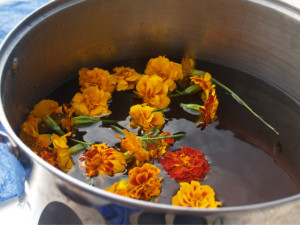By Guest Contributors Elissa Meyers and Mira Adornetto
After pulling out green cotton fabric from a naturally fermenting indigo vat, our workshop group watches excitedly as the green transitions into a dark indigo blue. This incredible process, which occurs as the indigo dye oxidizes has been used for thousands of years in numerous places and cultures. Throughout human history, color has been applied to fibers on every continent, starting as far back as 2,600 BCE. Plants, shellfish, and insects: wildflowers, trees, mollusks and bugs, have been used to dye fibers.
Since the industrial revolution dyeing went from natural colorants like plants and insects to synthesized petroleum based dyes, which are fairly damaging to the environment. The argument that modern “low-impact” dyes are less harmful to the environment than natural dyes has become a highly debated topic in the textile industry. Millions of tons of synthetic dye are still being dumped annually into waterways leaving textiles as one of the top ten worst polluted industries. Natural dyes, however, offer an alternative.
 Natural dyeing usually includes the use of a metallic salt, known as a “mordant,” from the French word “mordre” meaning “to bite.” Mordants include alum, iron, tin, chrome, copper, and also tannic acid. Tannins are readily available in the environment: they’re in black tea, as well as in oak trees and many other plants. Alum (sometimes used in food and cosmetics, though less often these days) is the most prevalent metal in the earth’s crust, followed by iron. These mordants can be used and disposed of safely. Although some of the other metals, tin and chrome for example, can produce more intense colors, they have a larger safety risk and environmental impact. These metals tend to give natural dyes a bad reputation as they are toxic to the environment. In fact, at BLUEREDYELLOW, we don’t even consider using them in our work.
Natural dyeing usually includes the use of a metallic salt, known as a “mordant,” from the French word “mordre” meaning “to bite.” Mordants include alum, iron, tin, chrome, copper, and also tannic acid. Tannins are readily available in the environment: they’re in black tea, as well as in oak trees and many other plants. Alum (sometimes used in food and cosmetics, though less often these days) is the most prevalent metal in the earth’s crust, followed by iron. These mordants can be used and disposed of safely. Although some of the other metals, tin and chrome for example, can produce more intense colors, they have a larger safety risk and environmental impact. These metals tend to give natural dyes a bad reputation as they are toxic to the environment. In fact, at BLUEREDYELLOW, we don’t even consider using them in our work.
Our society’s awareness of global environmental issues has increased substantially since the 60s. In today’s DIY culture more people want to use accessible and sustainable materials. People now are more concerned with where manufactured goods come from and what to use them for. When synthetic dyes hit the textile industry during the Industrial Revolution, natural dyes became nearly obsolete. However, craftspeople like William Morris, (known for his textile patterns) continued to work using the older, more craft-based, processes including natural dyeing. With today’s advancements in science and technology, we have a better understanding of the world around us. Yet there is still so much to learn in the world of natural dyes. Philadelphia was once a powerhouse of the textile industry. Currently, it is a region with an active and abundant arts community, with an emphasis on craftsmanship.
Aside from the arts, Philadelphia is abundant with urban gardens and is a region where a long list of dye plants can be grown and found. Some of these include mugwort, goldenrod, sunflowers, black-eyed Susans, mint, dock, and sorrel. There are several tannin bearing plants including black walnut and sumac. It is also possible to grow historical dye plants such as the Japanese variety of indigo dye (vibrant blue) as well as madder root (alizarin red). It is incredible how many options there are to produce color in this area and we hope the craft will continue to be explored in a local, as well as global, way.
About the Authors
Elissa Meyers and Mira Adornetto founded BLUEREDYELLOW, a design and natural dye house producing comfortable, chemical free textiles. BLUEREDYELLOW was founded with support from The Corzo Center for the Creative Economy. Currently, they work with businesses offering an alternative dye service and do piece dyeing as well as dyeing by the yard. Elissa and Mira also lead natural dyeing workshops around the Philadelphia area. They will be leading a two-day workshop at the Schuylkill Center on July 17 and 18.


Natural dyeing is art. Apart from them being environment-friendly, the results they convey are best. Isn’t it fair enough?